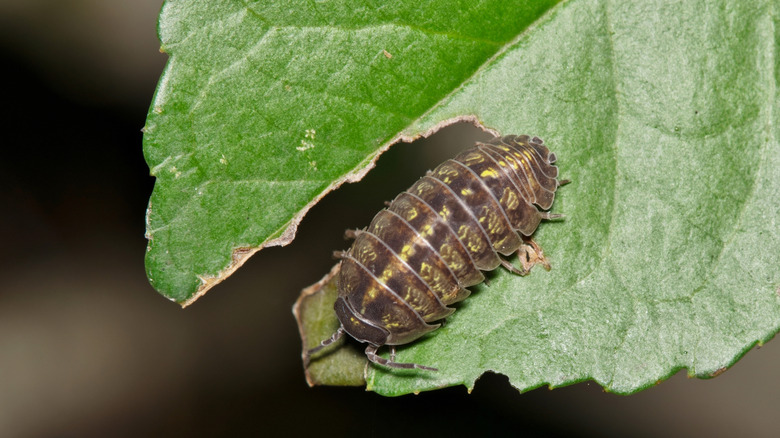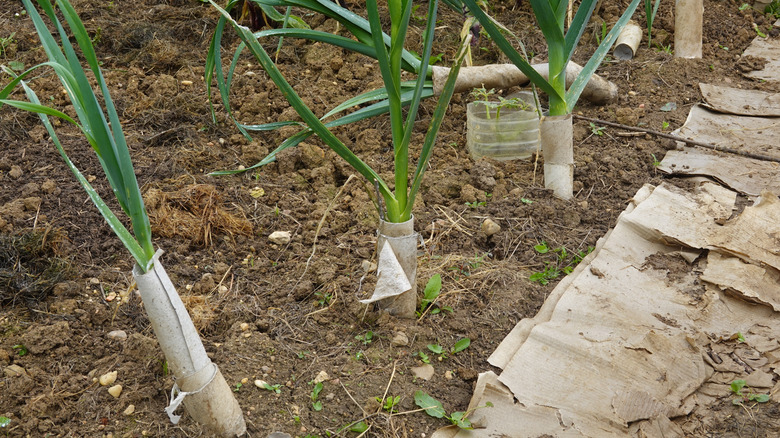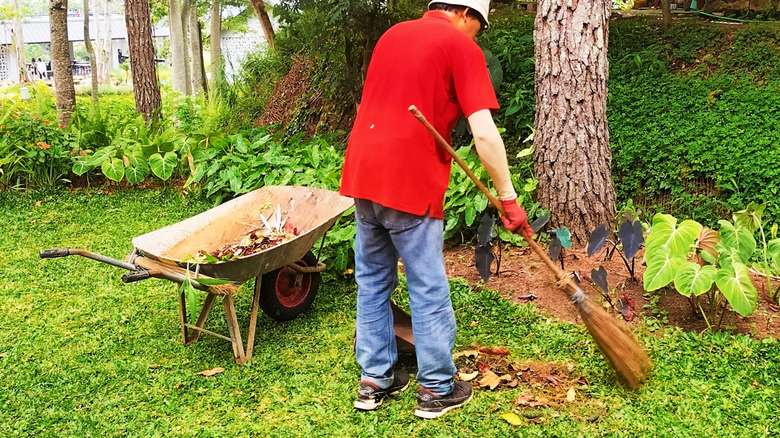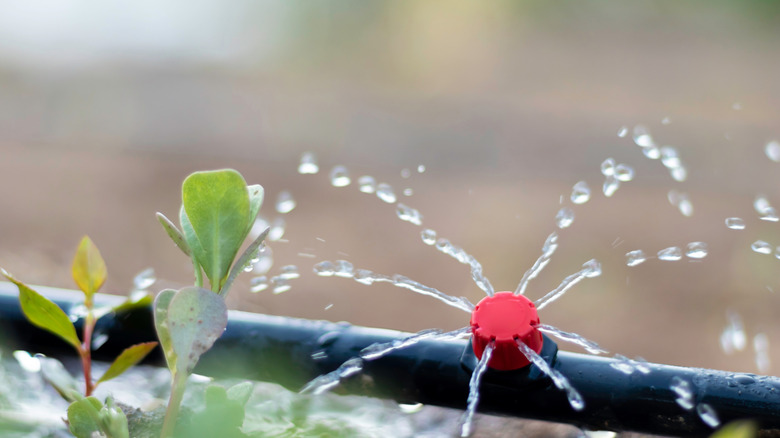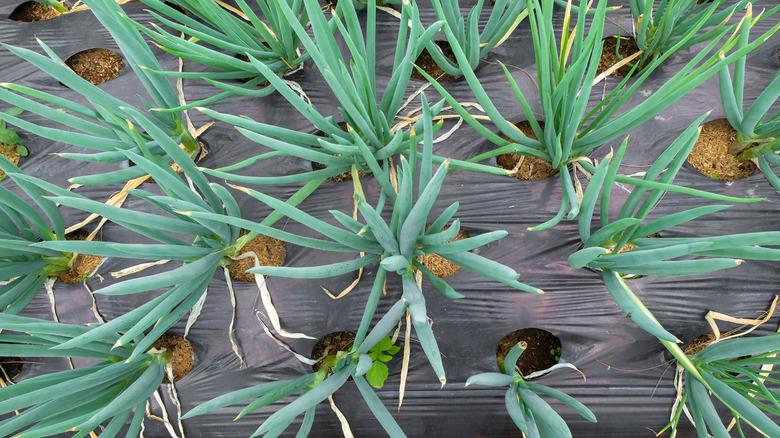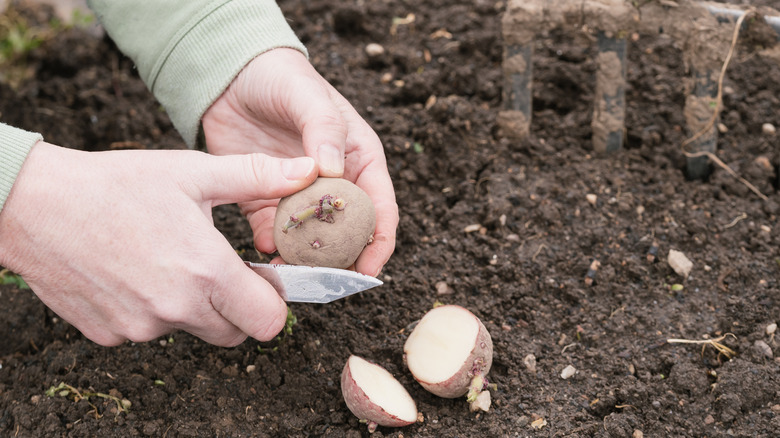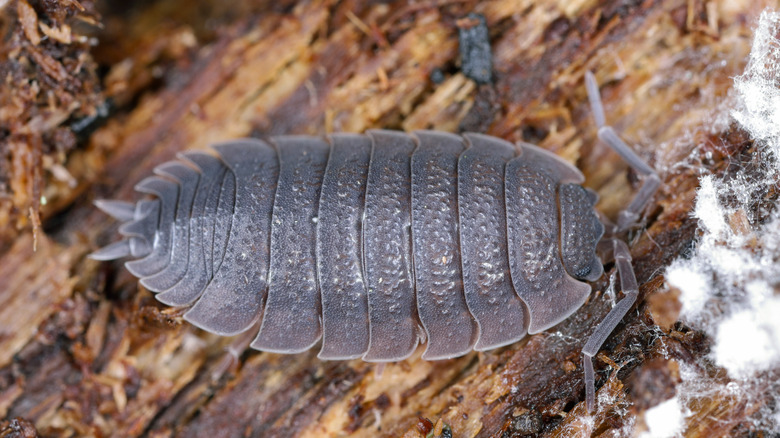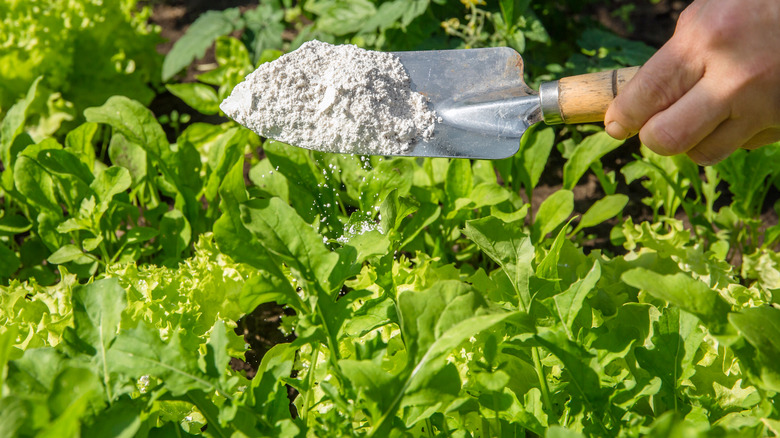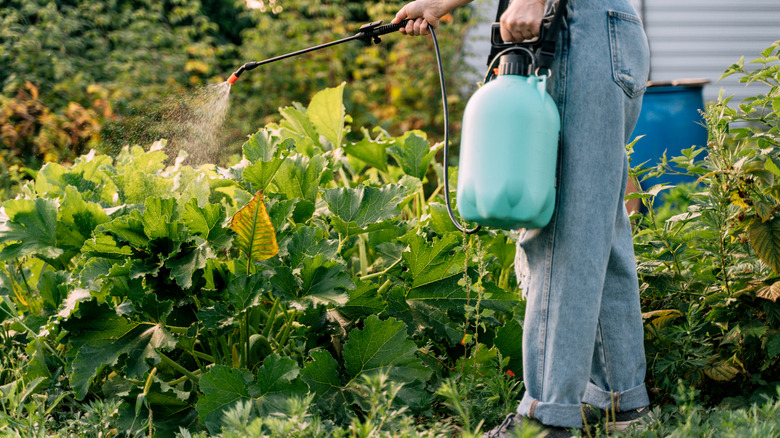Protect Your Plants With These Proven Methods To Control Pillbugs And Sowbugs
It's uncanny how some critters who were a source of awe and giggles during childhood have transformed into inconvenient menaces now that you garden. But that's just pillbugs for you. Curling into themselves, becoming pill-like when bothered, pillbugs, woodlice, or roly-polies are gray, seven-pair-legged crustaceans measuring under ½ inch. They also have sowbugs for doppelgänger, though they appear relatively flatter and cannot fold their bodies. Pillbugs and sowbugs are often tolerated in gardens, as their penchant for decomposing organic matter enables nutrient recycling and soil enrichment.
However, they can become a garden pest if their population explodes to unhealthy proportions — as it usually does after a heavy downpour. That's because they expand their palate to live plants to sustain their burgeoning populace, especially when sufficient detritus is unavailable. This means that you may lose your recently transplanted vegetables and ornamentals overnight. In the worst cases, they may also traipse inside your home, necessitating a pest control treatment. So, to avoid such outcomes, you must take the necessary measures to control (and eliminate) their buggy population. Removing their preferred harborage sites, collaring your young plants, baiting the bugs with suitable traps, and sprinkling diatomaceous earth are a few such methods, and all are explained below.
Collar your seedlings and juvenile plants
Pillbugs typically attack seedlings or small plants with direct soil contact. For instance, they target hosta or lettuce when they leaf out. Similarly, they feed on strawberry plants, as their fruits grow close to the ground. They also consume low-growing plants like cucumbers, pansies, zinnia, English primrose, and verbena. Given that, one effective way to shield your seedlings from pillbugs and sowbugs is to use collars.
Luckily, collars don't have to be fancy. You can simply wrap duct tape around the young plant's stem and leave it on until it matures (or outgrows the collar). Ensure its sticky side faces out and a part of the tape is buried in the ground (to protect the roots). Another option is to collar your seedlings with small newspaper strips. Since they're biodegradable, you won't have to worry about removing them afterward. You can even bury toilet paper cardboard tubes around 2 inches deep into the soil and transplant your seedling inside it for protection. However, for the best results, the foliage must take up most of the internal space, or some critters will find their way in. Disposable paper or plastic cups can serve a similar purpose when their ends are cut off. Keeping them on through spring may have the added advantage of banishing destructive cutworms.
Eliminate the bugs' favored harborage sites
Pillbugs and sowbugs are nocturnal eaters, making meals out of your new plantings when the lights are out. But this also implies that they're in a restive mode during the day. So, they're often on the lookout for the perfect cover to hide their crimes. Their most preferred sites? Anything moist and organically rich, such as grass clippings, leaf litter, decaying vegetables, weeds, and plant debris. For this reason, removing their favored cover sites is an easy way to discourage pillbugs and sowbugs from nesting inside your garden and damaging your plants.
Another way to flush the voracious critters out is to thin out the canopy. Or, at the very least, span the plants at a greater distance to avoid overcrowding and open up the garden beds. That way, you don't have to wait for cues — like half-chewed daisies — to take action, because you can easily spot the inactive bugs. Also, lift any firewood, planters, bricks, and containers off the ground, as they might retain moisture underneath, attracting pillbugs and sowbugs.
Lower the irrigation frequency (whenever feasible)
There is a reason pillbugs and sowbugs are drawn to moist environments: anatomy. Since these hard-bodied creatures are crustaceans (and not insects), they breathe through gills located on their undersides. To keep their gills functioning properly on land, they require constant access to water. Given this connection, limiting plant irrigation can yield positive results, as the environment will become unconducive for their survival. Naturally, if you adopt such a measure, you must ensure that your plants come to no harm and remain healthy and flowering.
When lowering the watering frequency isn't an option, try to move the watering schedule up in the morning. This way, the soil will have sufficient time to dry down before the bugs begin feeding. Also, it's ideal to leave sufficient gaps between irrigation sessions, allowing the soil to parch temporarily and hopefully eliminate a few poorly adapted pillbugs. Wherever possible, switch out sprinklers for drip irrigation systems. This not only ensures targeted watering and reduced water bills, but also prevents the area from becoming unnecessarily damp.
Limit the amount of mulch or go plastic
Gardeners often go to great lengths to score free mulch for their yard or garden. After all, it adds ornate beauty to the landscape, improves moisture retention, and keeps weeds down. Alas, mulch can also double up as a shelter site for pillbugs and sowbugs, particularly the longer it remains wet. Therefore, if you're serious about sending these bugs packing from your garden, be deliberate about your mulching choices.
For starters, don't layer the mulch thicker than 4 inches, or it will remain moist, attracting the water-seeking bugs. Even better, start with a 2-inch-thick layer and deposit more mulch only when the season becomes hot and dry (as retaining water becomes essential in such circumstances). Make sure to keep the mulch away from the plant's base, especially when new growth is emergent. Also, in case you're maintaining mulched beds near the foundation or entryway, ensure they're at least 12 inches away. Otherwise, the bugs may use them as their gateway to your interiors. For severe infestations, consider switching to black plastic mulches. This is because they remove the enabler: organic matter. However, note that these mulches affect water infiltration and must be holed through to create irrigation access. Plus, they may become too hot for certain vegetables and ornamentals.
Bait, trap, then remove the bugs
To get rid of the existing pillbug and sowbug infestation, consider laying down traps. In essence, you must appeal to the bugs' senses of self-preservation by putting down a moist food source, such as half-eaten fruits, potatoes, yeast water, or beer. Once the bugs fall for the bait (remember their need for water), you can dispose of them elsewhere or dunk them in a soapy water solution if they aren't dead already.
To DIY your trap, pour a few drops of oil into a tin can, jar, pan, or shallow container. Top off the oil with cheap beer. Teetotalers can alternatively use soy sauce or yeast water (make sure there are at least 2 tablespoons of yeast in it). Push the trap in the soil so that its rim is level with the ground. Since the bugs cannot scale the container's walls, they'll get trapped and eventually drown in the yeast water.
Otherwise, use a potato to keep roly polys from destroying your garden. Slice it in half and place it near the infestation. Check the potato pieces for bugs every morning and drop them in soapy water for elimination. Instead of potatoes, you can also use mango or citrus fruits (like oranges or grapefruits) and reuse them successively for a couple of days. Another option is to put duct tape on a newspaper cutting or paper roll tube and place it inside the infested area. Replace the traps after watering and rain.
Relocate the bugs using wooden boards
Another way to deal with woodlice is to use their habits against them. Since they enjoy decaying matter, they can be enticed out by scattering a few wooden boards inside the garden. When it's time for the sun to rise, they'll take cover under the wooden boards. Once that happens, you can safely move the boards and scrape off the bugs into a compost pile, far away from your desirable plants.
As established, sowbugs and pilbugs help decompose organic matter and will improve the compost. In fact, they often exist in the cooler portions of compost piles — though they eventually die down when sufficiently high temperatures are reached (and the pile is judiciously turned weekly). However, to avoid starting their infestation afresh, check the compost for bugs before using. If you're unsure, raise the pile's temperatures to 120 degrees Fahrenheit (or higher) to cook all the bugs. Alternatively, you may lay down a plastic tarp in a sunlit area and broadcast the usable compost on it. Make sure the tarp is at a considerable distance from your ornamentals, in case any bugs make it out alive. That being said, if you don't maintain compost piles (or don't wish to risk it), steep the bug-riddled wooden boards in soapy water.
Sprinkle diatomaceous earth in the garden
Amongst the many popular ways to use diatomaceous earth around your home and garden, banishing sowbugs once and for all is another worthy addition. Considered an organic pesticide, diatomaceous earth is composed of the skeletal corpses of aquatic organisms ("diatoms") that are typically silica-based. It's usually available as a powder, though liquid forms and wettable powders are also marketed. However, stick to food-grade variants, as they're purified and considered much safer. As for its function, diatomaceous earth behaves like a dehydrating agent, wicking moisture away from the bugs' bodies whenever they come in contact. As you know, sowbugs and pillbugs heavily depend on constant water access for survival, so diatomaceous earth can be quite deadly for them. Moreover, the organic powder slices into their bodies with its abrasive particles, furthering water loss and killing them.
So, to achieve the desired results, sprinkle the powder in thin layers in high-infested areas to ensure contact. Remember to apply it in the evenings (or late afternoons) when the bugs become active. Don't forget to reapply after irrigation or rainfall, as the powder is water-soluble and becomes ineffective when wet. Although diatomaceous earth poses no harm to birds or pets, it may be harmful to bees. So, avoid using it on pollinator-friendly plants (if possible). Also, wear a mask (and gloves) before application as inhaling the dust can be harmful. Similarly, avoid applications on windy days.
Spray pesticides as a last resort
In case DIY traps and organic pesticides fail to control the pillbug and sowbug problem, consider treading the synthetic route. Most garden centers stock "bug and slug" baits that target the roly poly bugs. However, you must check the label before application to make sure they're safe around the targeted plants (particularly edible ones). Follow the instructions to the T, as any misapplication can turn toxic for pets and children. Typically available as pellets, these baits are composed of food and a toxic chemical (usually a mix of iron phosphate and spinosad). Placing them near (minus any physical contact with the plants) the infestation encourages the bugs to consume them, leading to their untimely demise.
Another option to exterminate the bug problem is to broadcast or spray permethrin-based pesticides. But take this step only after you've removed all harborage and cover sites. These sprays can also be used before transplanting seedlings as a preemptive measure — and reapplied weekly until the plants mature. However, they risk hurting beneficial insects, too. That being said, pesticides containing lambda-cyhalothrin, cyfluthrin, or esfenvalerate as active ingredients also make suitable contenders. But avoid using carbaryl and acephate, because they aren't very effective against pillbugs and sowbugs.
